Developer: Konami Publisher: Konami Release: 12/06/91 Genre: Shooter
Life Force, alongside Gradius, was one of the defining shooters of my childhood. It was one of the first vertical (yes, I know it switches) shooters I had ever played which left an indelible impression on me. The similarities to Gradius also helped me like the game as well. I am sure I was not alone in thinking Life Force was the sequel to Gradius; Konami certainly marketed it as such. It would be many years later that I would learn that Life Force was actually Salamander, a wholly separate series from Konami. The PC Engine version is one of the few true ports of the game and overall fantastic.
Salamander is both similar to Gradius and not. Both games star the Vic Viper and feature mostly the same weapons. The primary difference here is the absence of the power-up bar. All weapons in Salamander are dropped from enemy’s whole cloth. This makes a huge difference in how fast you power up and in the game’s flow. The game is incredibly generous with power-ups; it is not unheard of to have a full complement of options, missiles, and a laser or ripple in less than a minute. Remembering each weapon icon can be tricky but really isn’t much of a concern.
The other key difference is in its structure. Salamander alternates between horizontal and vertical shooting. This could have been a recipe for disaster but the game is equally adept at both. It’s interesting to note some of the other differences between this and Life Force. Where Life Force adapted a biological theme Salamander is more straightforward (although all of these changes would be incorporated into a new version of the arcade game too). The fourth stage of Salamander was moved up to become the second level of Life Force. Sadly the original stages of Life Force are not present, which sucks. While they definitely seemed out of place (seriously an Egyptian themed level?) their presence would have increased the length of the game and made you feel like you got your money’s worth.
Compared to its sister series Salamander is easier by far. Gone are the instant respawns and in its place is a checkpoint system. Normally death in these games is soul crushing as you start from zero in a bad spot. But in Salamander it isn’t much of a detriment. The frequent weapon drops allow you to get up to speed quickly. At full power it is very easy to blitz through most of the game with little trouble. There are a few choke points, namely the blazing fire of stage three and especially the laser traps leading up to the finale. But those are few. The limited continues and missing Konami code are not enough to deter most from finishing this with little trouble.
Coming a year after Gradius Salamander was a significant step up in terms of presentation. Salamander was more varied in terms of levels, spending little time in open space. The initial outing takes place inside of an alien creature, complete with living brain as a boss. The fiery waves of the volcano area are impressive, both in their size and ferocity. One minor detail that seems quaint now is a unique boss for every level. The original repurposed the mothership at every turn while Salamander has level specific bosses. For a 1986 title the variety on display is astounding. For its time the PC Engine port was near arcade perfect outside of some missing background detail and resolution. It should also be noted this is a port of the Japanese arcade game so it is missing the silly bio organic theme of its western counterpart.
I say this is nearly arcade perfect because it does have some pretty heavy slowdown at points. Once you have four options and the Ripple the game will run in slow motion at times. This is most notable in the vertical levels. A screen filled with broken asteroids and five ripples turns this into a slide show. While annoying much like the Famicom version of Gradius II you can use it to your benefit. Inducing slowdown during boss battles makes these fights trivial. Too bad you can’t slow down the final escape segment.
In Closing
Salamander is a great game and an excellent addition to the PC Engine/Turbo Grafx-16 library. Salamander should have been released overseas; despite the glut of shooters at the time there is always room for a quality title. It may be redundant thanks to the Salamander Deluxe packs but is still worth seeking out as an alternative.


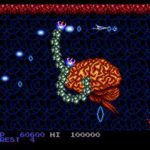
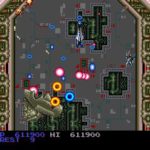

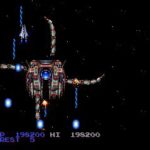
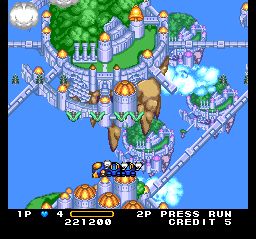
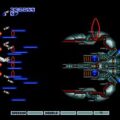

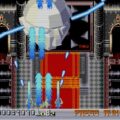
One thought on “Salamander”